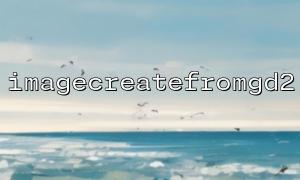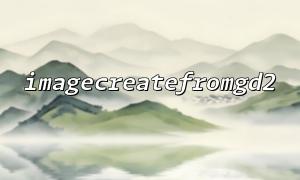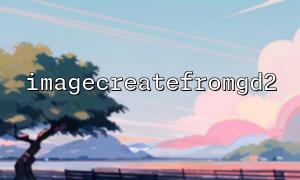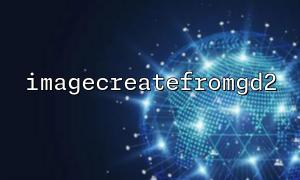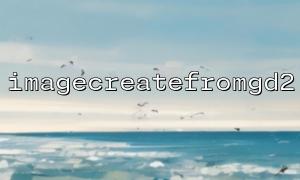In PHP, the imagecreatefromgd2 function is used to create an image resource from an image file in GD2 format. GD2 is a file format of the GD library (a library for image processing), which is commonly found in image editing or dynamic image generation. This article will introduce in detail how to use the imagecreatefromgd2 function to handle uploaded GD2 files and solve some common problems that may be encountered during use.
When processing uploaded files, you must first make sure that the type and format of the files are in line with expectations. For GD2 files, we need to confirm whether the uploaded file is a valid GD2 image file. This is not only to avoid errors, but also helps protect the system from malicious file attacks.
When uploading a file, the uploaded file can be accessed through the $_FILES array. For example:
if ($_FILES['image']['error'] == UPLOAD_ERR_OK) {
$uploadedFile = $_FILES['image']['tmp_name'];
$fileType = mime_content_type($uploadedFile);
// Check if the file type isGD2Format
if ($fileType == 'image/vnd.gd2') {
// Continue to process the file
} else {
echo "Please upload validGD2Image File!";
exit;
}
} else {
echo "File upload failed!";
exit;
}
In this example, we first check whether the upload is successful, and then use the mime_content_type function to verify whether the file is in GD2 image format. We will continue to perform image processing operations only after the file type verification is passed.
Once we have verified the format of the file, we can use the imagecreatefromgd2 function to load the uploaded GD2 image file. This function will return an image resource, which can be processed later, such as cropping, scaling, converting formats, etc.
$image = imagecreatefromgd2($uploadedFile);
if ($image === false) {
echo "Unable to loadGD2document!";
exit;
}
// After the image is loaded successfully,Perform follow-up processing
If the imagecreatefromgd2 function fails to load the file, it will return false , so it needs to be handled incorrectly.
The imagecreatefromgd2 function itself does not change the image format. If you need to convert the loaded GD2 image to other formats (such as PNG, JPEG, etc.), you can use imagepng , imagejpeg and other functions to convert.
For example, convert the loaded GD2 image to PNG format:
$pngFile = 'converted_image.png';
if (imagepng($image, $pngFile)) {
echo "The image has been successfully converted toPNGFormat!";
} else {
echo "Image conversion failed!";
}
Similarly, you can save it in JPEG format using imagejpeg , or use other functions to convert as needed.
When using imagecreatefromgd2 , you may encounter the following common problems:
Issue 1: GD2 file failed to load
If the image fails to load, it may be due to the following reasons:
The file is not a valid GD2 image file.
The file is corrupted.
PHP does not have GD library installed, or the GD library does not support the GD2 format.
Solution:
Make sure the uploaded file is a valid GD2 image and is not corrupted.
Check whether the GD library is enabled on the server, especially the version that supports GD2 format. You can view the details of the GD library through phpinfo() .
Problem 2: File format conversion failed
Sometimes even if imagecreatefromgd2 loads the image, the process of converting the format can still fail. This is usually caused by a target file path or permissions issue.
Solution:
Make sure the target path is writable and the file has no permissions.
Check PHP's error log for more information.
Issue 3: Memory limit causes loading failure
GD2 files can sometimes be very large and require more memory when loading. If you encounter insufficient memory, you can try to increase the memory limit of PHP.
ini_set('memory_limit', '256M'); // Increase memory limit
Try again after increasing the memory limit, which usually solves this problem.
The above is the basic method of using the imagecreatefromgd2 function to handle uploaded GD2 files, as well as the analysis of common problems. Correct file verification, reasonable image conversion and processing steps, and timely error checks can allow you to perform image operations more smoothly.

